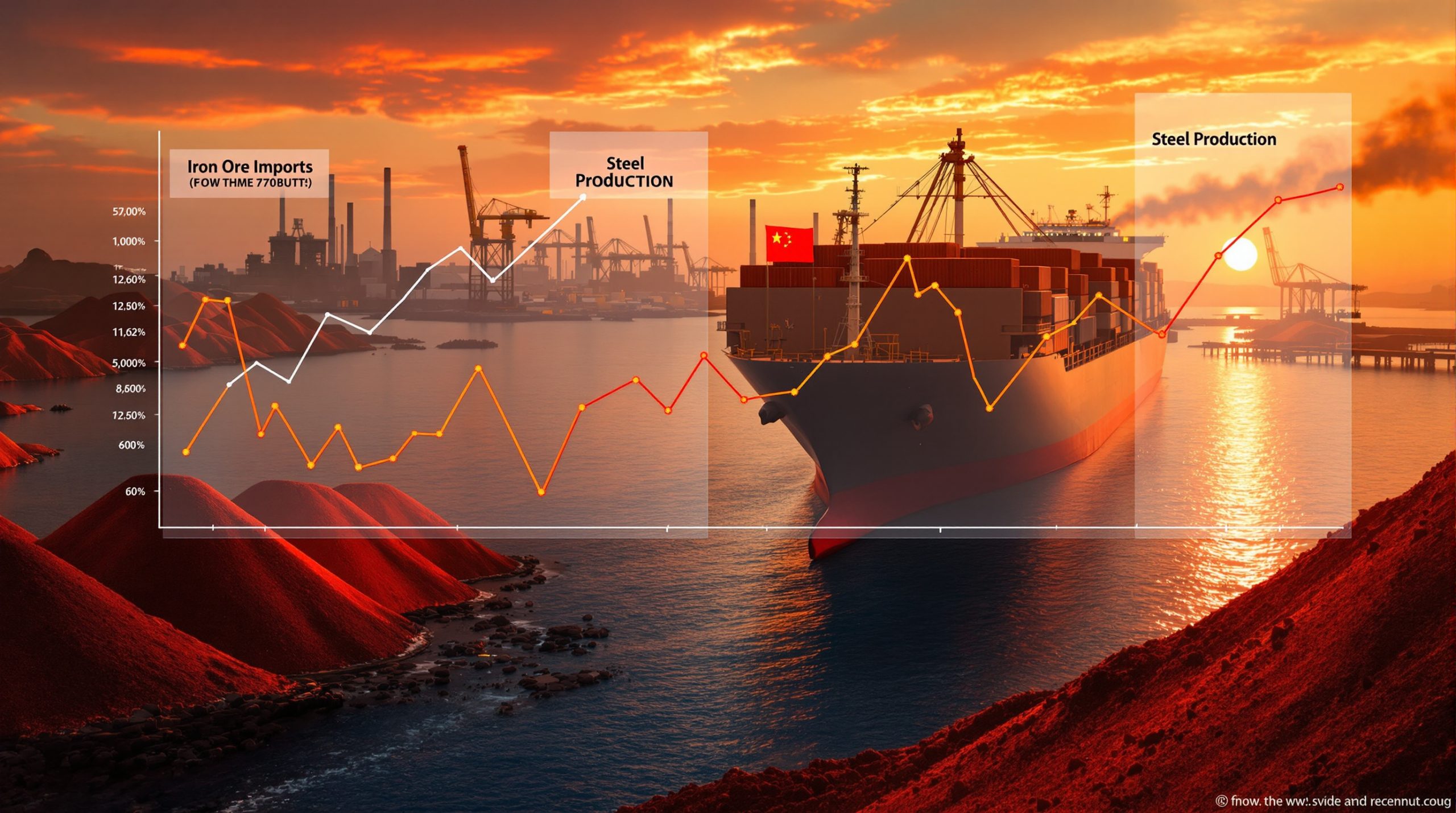What is Causing the Recent Decline in Magnesium Prices?
The magnesium market is currently experiencing a notable downward trend with prices falling across both Chinese domestic and international markets. As of July 16, 2025, magnesium ingot prices in China's Fugu region have decreased to 16,150-16,250 yuan/mt, representing a 50 yuan decline from the previous trading day. Similarly, China's FOB export prices have dropped to $2,240-$2,300/mt, down $10 from prior rates.
This decline comes amid weakening demand signals in both domestic and international markets, creating persistent downward pressure on prices despite producer efforts to maintain higher price levels.
Supply-Demand Imbalance Factors
The primary driver behind the current price weakness appears to be a fundamental imbalance between supply and demand dynamics. While production has remained relatively stable, market demand has softened considerably, creating natural price depreciation pressures.
Several key factors are contributing to this imbalance:
- Reduced foreign trade inquiries – International buyers have significantly decreased their inquiry volumes
- Strong wait-and-see sentiment – Buyers are delaying purchases in anticipation of further price drops
- Just-in-time procurement shift – Both domestic and international markets have moved away from stockpiling
- Resistance to bulk purchases – End-users are hesitant to commit to larger volumes amid uncertainty
This shift in procurement strategies has created a self-reinforcing cycle where buyers delay purchases, causing prices to drop further, which in turn reinforces waiting behavior among potential buyers.
Market Analysis: "The persistent gap between stable supply and falling demand creates inherent price depreciation pressures that producers are struggling to counter through traditional price support mechanisms." – SMM Market Analysis, July 2025
How Are Domestic and International Markets Responding?
Chinese Domestic Market Conditions
The domestic magnesium market in China shows clear signs of strain with sluggish trading in domestic and foreign magnesium markets. Current mainstream transaction prices are holding at 16,150-16,200 yuan/mt, though producers are showing notable reluctance to further reduce prices despite mounting market pressure.
A key characteristic of the current market is the limited availability of material at the lower price point (16,150 yuan/mt), with some of these offerings raising quality concerns among buyers. This has created a quality-differentiated market where verified high-quality material commands a premium.
Producers have implemented strategic inventory control tactics, preferring to maintain price discipline rather than slash prices to stimulate demand. This approach reflects producer confidence that current price weakness may be temporary, though market conditions continue to challenge this position.
International Market Dynamics
The global magnesium trade is experiencing similar challenges with several distinct patterns emerging:
- Asian procurement strategies – Nearly all Asian buyers have adopted just-in-time procurement methods
- Lower price range clustering – Transaction prices are concentrated at the lower end (FOB $2,250/mt)
- Volume constraints – Trading volumes remain limited across all major markets
- Wait-and-see attitudes – End-users are predominantly observing rather than actively participating
- Forward contract hesitancy – Buyers are reluctant to commit to future deliveries amid uncertainty
The current international market environment demonstrates buyer leverage in price negotiations, with sellers increasingly willing to accommodate lower price points to secure transactions in a highly competitive environment.
Logistics Impact: Transportation costs continue to represent a significant component of delivered magnesium prices, particularly for international shipments. Recent logistics challenges have amplified regional price differentials, creating additional complexity in the global market.
What Factors Are Influencing Buyer Behavior?
Shift in Procurement Strategies
A fundamental transformation in procurement approaches is occurring across the magnesium market, reflecting both tactical responses to current market conditions and strategic adaptations to broader economic uncertainties.
The most significant changes include:
- Abandonment of stockpiling – Buyers have moved away from building inventory to minimize price risk exposure
- Heightened price sensitivity – Traditional buyers are negotiating more aggressively on price points
- Focus on immediate needs – Purchasing decisions are increasingly driven by short-term requirements
- Quality scrutiny – Enhanced verification of product specifications, particularly for lower-priced offerings
- Strategic waiting periods – Deliberate delays in purchasing to capitalize on potential further price declines
This behavioral shift has direct implications for market dynamics, as the collective buyer tendency to delay purchases creates a self-reinforcing downward price pressure mechanism.
Regional Demand Variations
Different markets are exhibiting varying levels of demand resilience, with notable patterns emerging across regions:
- Asian markets show the most pronounced procurement hesitancy, with buyers systematically delaying purchases
- Domestic Chinese buyers are maintaining minimal necessary purchasing while avoiding any inventory build
- Export market inquiries have decreased more significantly than domestic interest, indicating stronger international caution
- Quality-sensitive sectors (particularly automotive and aerospace) maintain more stable demand patterns due to specific material requirements
The more pronounced decline in export inquiries compared to domestic orders suggests international buyers may be more pessimistic about near-term market conditions or have access to alternative supply sources.
What Are the Short-Term Market Outlook Predictions?
Price Trajectory Expectations
Market analysts anticipate continued price pressure in the short term, with little indication of immediate recovery. This outlook is based on several persistent factors:
- Sustained demand weakness across major consumption sectors
- Insufficient producer price stabilization efforts to counter market forces
- Limited prospects for demand revival in the immediate term
- Continued buyer preference for minimal inventory positions
- Potential for further modest price adjustments in the downward direction
While dramatic price collapses appear unlikely given producer price discipline, the path to price recovery remains unclear without significant demand catalyst events or supply-side adjustments. Furthermore, commodities market volatility continues to affect investor confidence and pricing stability.
Supply-Side Responses
Producers are implementing various strategies to navigate the challenging market environment:
- Maintaining production discipline – Avoiding significant volume reductions despite price pressure
- Enforcing price floors – Resisting further price erosion below certain thresholds
- Quality differentiation – Emphasizing material specifications to justify premium pricing
- Customer prioritization – Focusing resources on established, reliable customers
- Strategic inventory management – Carefully balancing production with market demand
These producer strategies reflect a calculated approach to weather what many industry participants hope will be a temporary market downturn rather than a long-term structural shift in demand patterns.
Disclaimer: Market forecasts are based on current conditions and subject to change based on unforeseen economic developments, policy changes, or supply chain disruptions. Readers should consider these projections as informational rather than definitive.
How Does Quality Variation Impact the Magnesium Market?
Quality Differentials and Pricing
The market exhibits notable price stratification based on product quality specifications, creating a multi-tiered pricing structure despite overall market weakness:
- Higher-quality magnesium commands price premiums of approximately 5.6% (up to 16,250 yuan/mt versus 16,150 yuan/mt for standard material)
- Lower-priced offerings (around 16,150 yuan/mt) are frequently associated with quality concerns
- Buyers have become increasingly discriminating about quality specifications even when seeking lower prices
- Price sensitivity is carefully balanced against quality requirements, particularly for critical applications
- Quality verification has gained importance as a prerequisite for transaction completion
This quality-based price differentiation creates a market floor for premium material, as even price-sensitive buyers remain unwilling to compromise on quality for critical applications. The industry has developed a mineral deposit tiers guide to help classify different quality levels of raw materials.
Industry Standards and Compliance
Quality considerations have emerged as crucial market differentiators in the current environment:
- Stringent buyer specifications – Requirements for purity levels (typically Mg ≥99.8%) and consistency
- Enhanced production scrutiny – Greater focus on process controls and quality assurance
- Premium positioning – Market advantage for producers with established quality reputations
- Widening quality gap – Growing distinction between commodity-grade and high-specification magnesium
- Verification importance – Increased reliance on certification and quality documentation
The emphasis on quality creates both challenges and opportunities for market participants. While it places additional burdens on producers, it also provides a mechanism for differentiation beyond price competition alone.
Technical Note: Industry standards such as ASTM B92/B92M-22 provide specific guidelines for magnesium alloy specifications, serving as objective benchmarks for quality verification in commercial transactions.
What Are the Key Indicators to Monitor for Market Recovery?
Demand Signal Indicators
Several key metrics will signal potential market improvement and should be closely monitored:
- Inquiry volume increases – Particularly from international buyers
- Procurement strategy shifts – Movement from just-in-time to forward planning
- Commitment to larger volumes – Willingness to secure larger purchase quantities
- Reduced price negotiation intensity – Less aggressive buyer push for discounts
- Extended planning horizons – Buyer interest in delivery beyond immediate needs
These demand indicators typically appear sequentially, with increased inquiry volumes serving as the earliest signal of potential market recovery, followed by more substantial commitment behaviors. The iron ore price forecast also provides context for related commodity markets.
Supply-Side Adjustment Indicators
Producer behavior provides important clues about market direction:
- Production volume adjustments – Changes in output in response to demand signals
- Inventory level fluctuations – Drawdowns or builds at major production centers
- Price stabilization efforts – Coordination among leading producers on pricing discipline
- Strategic production decisions – Implementation of planned curtailments or expansions
- Negotiation flexibility changes – Shifts in producer willingness to accommodate price requests
The interaction between these demand and supply indicators creates the framework for anticipating market turning points, with particular attention warranted to the sequence and intensity of signal changes. Recent iron ore surplus analysis suggests similar patterns may emerge in the magnesium market.
FAQ: Understanding the Magnesium Market
What are the primary end-use sectors for magnesium?
Magnesium finds application across diverse industries, with the most significant consumption in:
- Aluminum alloying – Adding strength, corrosion resistance, and workability
- Automotive die casting – Creating lightweight structural components
- Titanium production – Serving as a reducing agent in titanium manufacturing
- Steel desulfurization – Removing sulfur impurities in steel production
The market is particularly influenced by demand trends in automotive, aerospace, and construction industries, with transportation sectors representing approximately 45% of global consumption due to lightweighting initiatives.
How do transportation costs impact magnesium pricing?
Transportation costs represent a significant component of delivered magnesium prices, creating meaningful regional price differentials:
- International shipping expenses can add 8-12% to delivered costs
- Regional logistics challenges create temporary price spikes in specific markets
- Fuel price fluctuations introduce additional volatility to delivered pricing
- Container availability issues have disrupted traditional shipping patterns
- Alternative routing costs can significantly impact landed prices
These logistics factors contribute to complex pricing structures and can temporarily insulate regional markets from global price movements when significant transportation disruptions occur. Efficient iron haulage operations remain crucial for maintaining cost-effective material transport.
What role does magnesium play in lightweight materials development?
Magnesium remains a critical material for lightweight applications across transportation sectors:
- 33% weight reduction compared to aluminum for equivalent structural components
- 75% lighter than steel alternatives for certain applications
- Energy efficiency improvements of 1.5-2% for each 100kg of vehicle weight reduction
- Crucial component in next-generation multi-material vehicle designs
- Growing adoption in electric vehicle platforms seeking extended range capabilities
Despite current market challenges, long-term demand is supported by ongoing lightweighting initiatives in automotive and aerospace industries, particularly as fuel efficiency and emissions standards continue to tighten globally.
How do seasonal factors affect magnesium production and pricing?
Production costs and market demand exhibit seasonal patterns that influence market dynamics:
- Energy price fluctuations – Particularly in winter months in northern China production regions
- Construction cycle impacts – Seasonal building activity affects downstream demand
- Automotive production schedules – Model changeovers and production planning create demand cycles
- Transportation constraints – Weather-related shipping disruptions in certain seasons
- Inventory management strategies – Year-end adjustments and fiscal period considerations
These seasonal factors create predictable patterns in production costs and market demand that experienced market participants incorporate into their strategic planning.
Disclaimer: The magnesium market is subject to various factors beyond those discussed in this article. Readers should consult with industry experts and conduct thorough due diligence before making significant business or investment decisions based on market projections.
Looking to Gain an Edge in ASX Mineral Discoveries?
Discover significant mineral announcements before the broader market with Discovery Alert's proprietary Discovery IQ model, transforming complex ASX announcements into actionable investment insights. Explore historic examples of exceptional returns from major discoveries by visiting our dedicated discoveries page and start your 30-day free trial today.




